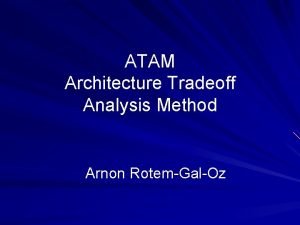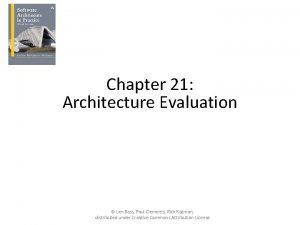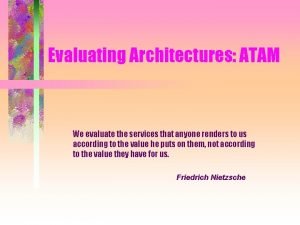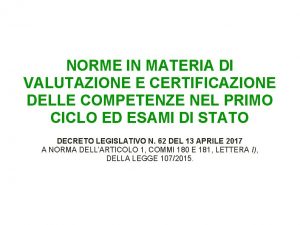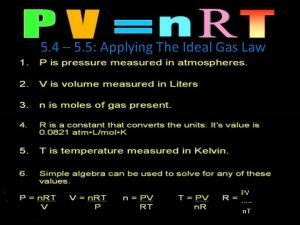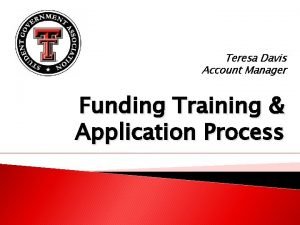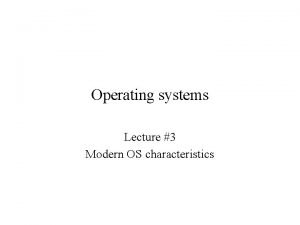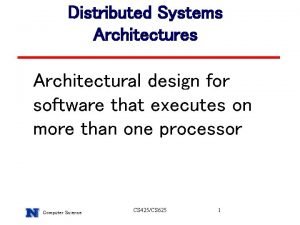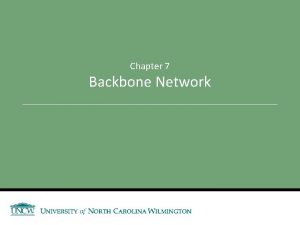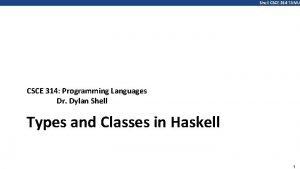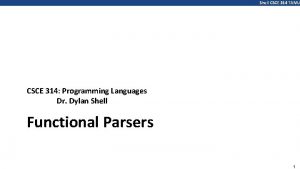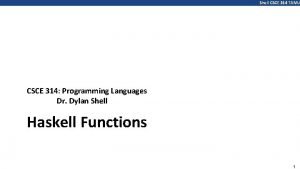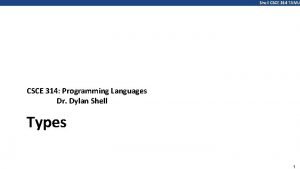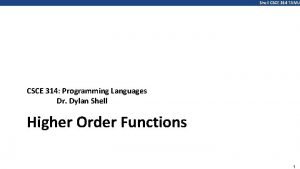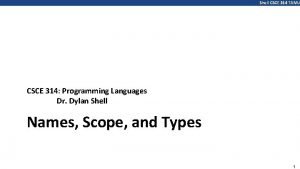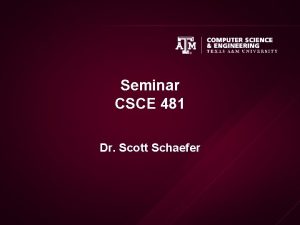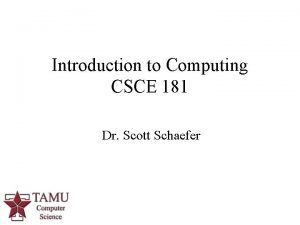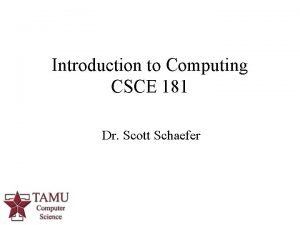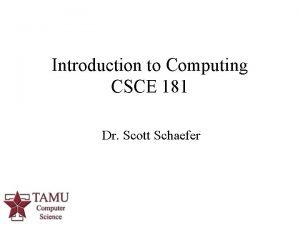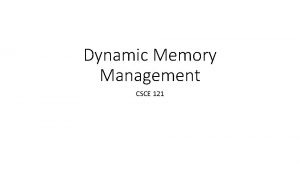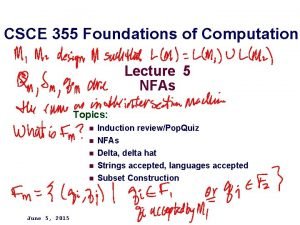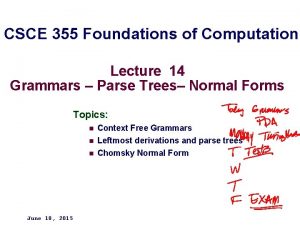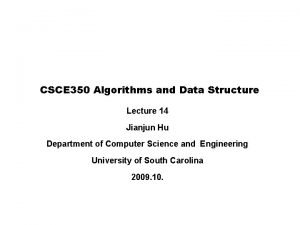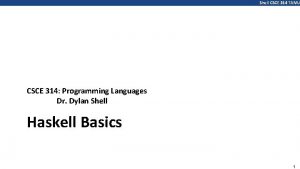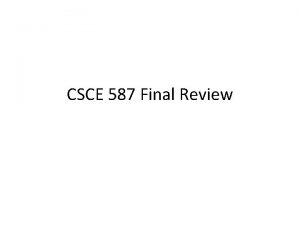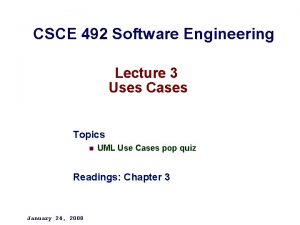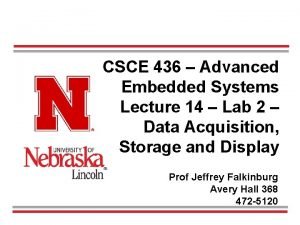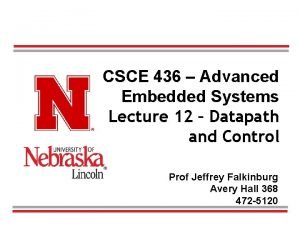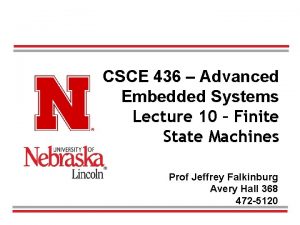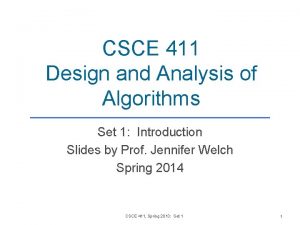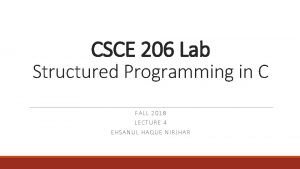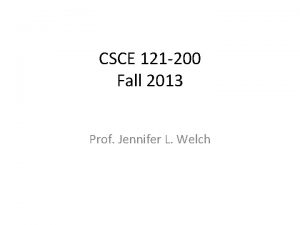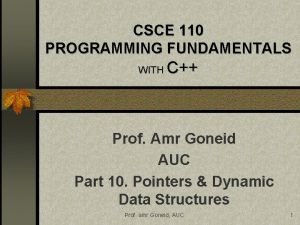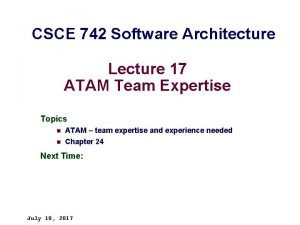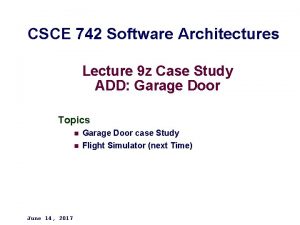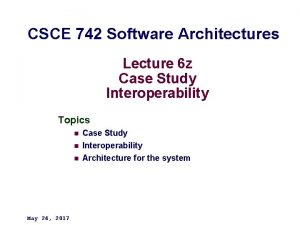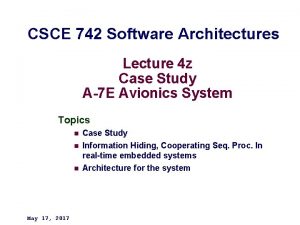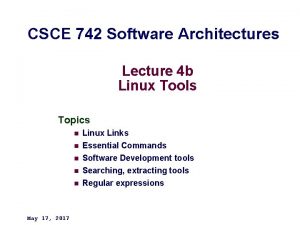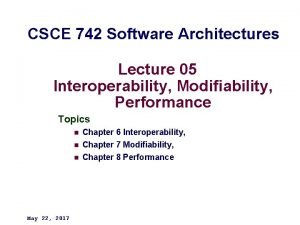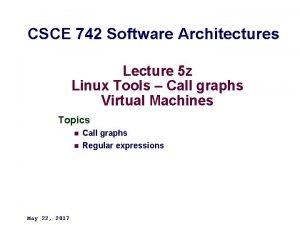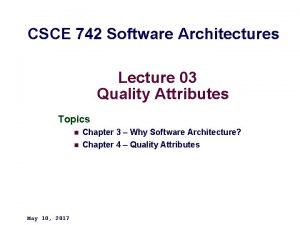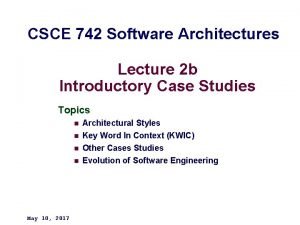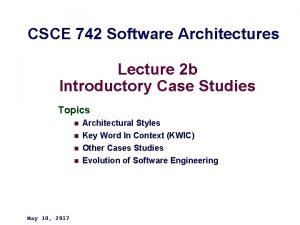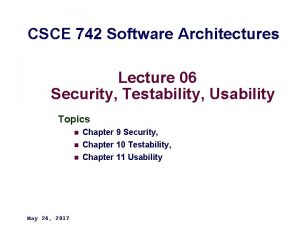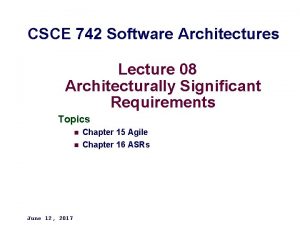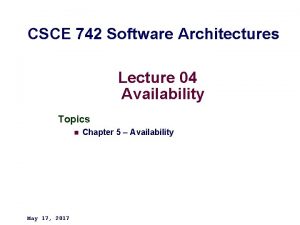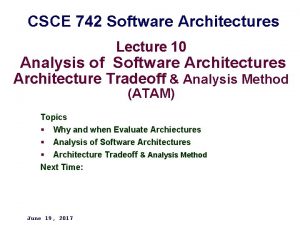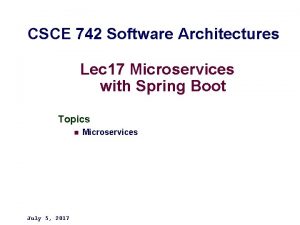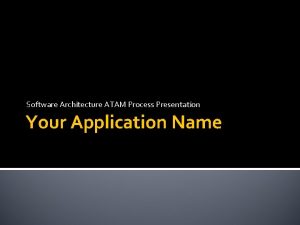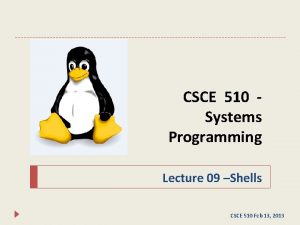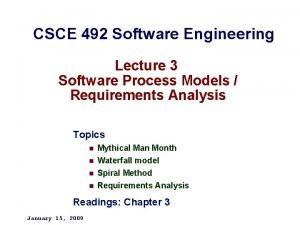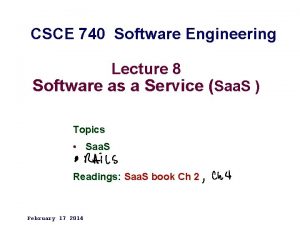CSCE 742 Software Architectures Lecture 14 ATAM Case

![Inputs [ ] Description of important attribute-specific requirements from Phase 0, Step 2, and Inputs [ ] Description of important attribute-specific requirements from Phase 0, Step 2, and](https://slidetodoc.com/presentation_image/c4189e0a64cb3bbacebceea2b8ef3943/image-2.jpg)
![Activities [ ] Architect describes technical constraints, other systems with which the system must Activities [ ] Architect describes technical constraints, other systems with which the system must](https://slidetodoc.com/presentation_image/c4189e0a64cb3bbacebceea2b8ef3943/image-3.jpg)
![Outputs [ ] Summary of architecture presentation, recorded by proceedings scribe. [ ] Architecture Outputs [ ] Summary of architecture presentation, recorded by proceedings scribe. [ ] Architecture](https://slidetodoc.com/presentation_image/c4189e0a64cb3bbacebceea2b8ef3943/image-4.jpg)






![Inputs [ ] Description of important attribute-specific requirements from Phase 0, Step 2, and Inputs [ ] Description of important attribute-specific requirements from Phase 0, Step 2, and](https://slidetodoc.com/presentation_image/c4189e0a64cb3bbacebceea2b8ef3943/image-11.jpg)
![Activities [ ] Evaluation team identifies approaches inherent in the architecture as presented. Options: Activities [ ] Evaluation team identifies approaches inherent in the architecture as presented. Options:](https://slidetodoc.com/presentation_image/c4189e0a64cb3bbacebceea2b8ef3943/image-12.jpg)

![Activities [ ] Evaluation leader facilitates the identification, prioritization, and refinement (to scenarios) of Activities [ ] Evaluation leader facilitates the identification, prioritization, and refinement (to scenarios) of](https://slidetodoc.com/presentation_image/c4189e0a64cb3bbacebceea2b8ef3943/image-14.jpg)
![[ ] Facilitate identification of quality attribute scenarios as fourth-level nodes. [ ] Ask [ ] Facilitate identification of quality attribute scenarios as fourth-level nodes. [ ] Ask](https://slidetodoc.com/presentation_image/c4189e0a64cb3bbacebceea2b8ef3943/image-15.jpg)
![[ ] Questioners make sure that important quality attributes are represented in the tree [ ] Questioners make sure that important quality attributes are represented in the tree](https://slidetodoc.com/presentation_image/c4189e0a64cb3bbacebceea2b8ef3943/image-16.jpg)
![Inputs [ ] Business drivers and quality attributes from Step 2. [ ] List Inputs [ ] Business drivers and quality attributes from Step 2. [ ] List](https://slidetodoc.com/presentation_image/c4189e0a64cb3bbacebceea2b8ef3943/image-17.jpg)















![Phase 1 Step 6 Checklist Inputs [ ] Utility tree from Step 5. [ Phase 1 Step 6 Checklist Inputs [ ] Utility tree from Step 5. [](https://slidetodoc.com/presentation_image/c4189e0a64cb3bbacebceea2b8ef3943/image-33.jpg)
![Activities [ ] Architect identifies components, connectors, configuration, and constraints relevant to the highest Activities [ ] Architect identifies components, connectors, configuration, and constraints relevant to the highest](https://slidetodoc.com/presentation_image/c4189e0a64cb3bbacebceea2b8ef3943/image-34.jpg)
![Outputs [ ] Analysis of architectural approach templates, filled out for analyzed scenario. [ Outputs [ ] Analysis of architectural approach templates, filled out for analyzed scenario. [](https://slidetodoc.com/presentation_image/c4189e0a64cb3bbacebceea2b8ef3943/image-35.jpg)







![Phase 2, Step 0: Prepare for Phase 2 Inputs [ ] All outputs generated Phase 2, Step 0: Prepare for Phase 2 Inputs [ ] All outputs generated](https://slidetodoc.com/presentation_image/c4189e0a64cb3bbacebceea2b8ef3943/image-43.jpg)
![Evaluation leader communicates these points to the client: [ ] Reiterate the scope of Evaluation leader communicates these points to the client: [ ] Reiterate the scope of](https://slidetodoc.com/presentation_image/c4189e0a64cb3bbacebceea2b8ef3943/image-44.jpg)
![[ ] Ask for architecture documentation that was needed but missing during Phase 1. [ ] Ask for architecture documentation that was needed but missing during Phase 1.](https://slidetodoc.com/presentation_image/c4189e0a64cb3bbacebceea2b8ef3943/image-45.jpg)
![Outputs of Phase 2 Step 0 [ ] Action item list and assignments, including Outputs of Phase 2 Step 0 [ ] Action item list and assignments, including](https://slidetodoc.com/presentation_image/c4189e0a64cb3bbacebceea2b8ef3943/image-46.jpg)



![Input [ ] Scenarios from the leaves of the utility tree developed during Step Input [ ] Scenarios from the leaves of the utility tree developed during Step](https://slidetodoc.com/presentation_image/c4189e0a64cb3bbacebceea2b8ef3943/image-50.jpg)
![[ ] Tell participants not to be constrained by the utility tree structure, attributes [ ] Tell participants not to be constrained by the utility tree structure, attributes](https://slidetodoc.com/presentation_image/c4189e0a64cb3bbacebceea2b8ef3943/image-51.jpg)

![Evaluation leader facilitates prioritizing of scenarios. [ ] Allow 5 minutes for the consideration Evaluation leader facilitates prioritizing of scenarios. [ ] Allow 5 minutes for the consideration](https://slidetodoc.com/presentation_image/c4189e0a64cb3bbacebceea2b8ef3943/image-53.jpg)
![[ ] Assign n votes to each participating member of the audience (including evaluation [ ] Assign n votes to each participating member of the audience (including evaluation](https://slidetodoc.com/presentation_image/c4189e0a64cb3bbacebceea2b8ef3943/image-54.jpg)
![[ ] Use any naturally occurring break in the tallies to separate the high [ ] Use any naturally occurring break in the tallies to separate the high](https://slidetodoc.com/presentation_image/c4189e0a64cb3bbacebceea2b8ef3943/image-55.jpg)
![[ ] After prioritization, facilitate assignment of each high -priority scenario to a place [ ] After prioritization, facilitate assignment of each high -priority scenario to a place](https://slidetodoc.com/presentation_image/c4189e0a64cb3bbacebceea2b8ef3943/image-56.jpg)
![Outputs of Phase 2 Step 7 [ ] List of high-priority scenarios. [ ] Outputs of Phase 2 Step 7 [ ] List of high-priority scenarios. [ ]](https://slidetodoc.com/presentation_image/c4189e0a64cb3bbacebceea2b8ef3943/image-57.jpg)






- Slides: 63

CSCE 742 Software Architectures Lecture 14 ATAM Case Study II Earth Observing System Topics n ATAM Case Study Continued Ref: The “Evaluating Architectures” book Chap 6 June 28, 2017
![Inputs Description of important attributespecific requirements from Phase 0 Step 2 and Inputs [ ] Description of important attribute-specific requirements from Phase 0, Step 2, and](https://slidetodoc.com/presentation_image/c4189e0a64cb3bbacebceea2b8ef3943/image-2.jpg)
Inputs [ ] Description of important attribute-specific requirements from Phase 0, Step 2, and Phase 1, Step 2. ] All available documentation for architecture being evaluated. [ ] Description of any attribute-specific architectural approaches from Phase: 0, Step 2. [ ] Sample quality attribute characterizations, such as those shown in Chapter 5. – 2– CSCE 742 Summer 2017
![Activities Architect describes technical constraints other systems with which the system must Activities [ ] Architect describes technical constraints, other systems with which the system must](https://slidetodoc.com/presentation_image/c4189e0a64cb3bbacebceea2b8ef3943/image-3.jpg)
Activities [ ] Architect describes technical constraints, other systems with which the system must interact, and attribute-specific architectural approaches. [ ] Proceedings scribe records highlights of architect's explanations. [ ] All evaluation team members note architectural approaches used/mentioned, potential risks in light of drivers, and additional stakeholder roles mentioned. – 3– CSCE 742 Summer 2017
![Outputs Summary of architecture presentation recorded by proceedings scribe Architecture Outputs [ ] Summary of architecture presentation, recorded by proceedings scribe. [ ] Architecture](https://slidetodoc.com/presentation_image/c4189e0a64cb3bbacebceea2b8ef3943/image-4.jpg)
Outputs [ ] Summary of architecture presentation, recorded by proceedings scribe. [ ] Architecture presentation materials. – 4– CSCE 742 Summer 2017

Phase 1 Step 3 Present the Architecture How it Went l Project manager and one of architects took turns l Key subsystems of ECS are n n n Data management Data server Data ingestion Data processing and planning Management interoperability User interface l Automatic “pushing” of data into system l “Pulling” selected pieces of data for scientific community l Common metamodel for ECS data (fig 6. 9) – 5– CSCE 742 Summer 2017

View of ECS Components – 6– CSCE 742 Summer 2017

Phase 1 Step 3 Present the Architecture How it Went continued l Data Management and Data Server Subsystems n n n Data Management Subsystems - incoming Data Server Subsystems – handle queries and distribution Metamodel figure 6. 9 l Data Ingestion Subsystem l Data Processing and Planning Subsystems n n Data products – higher level abstractions of raw data Routine production requests On-demand requests In the future product requests (e. g. , a data acquisition request) l Management and Interoperability Subsystems l User Interface Subsystem – 7– CSCE 742 Summer 2017

ECS Data Pyramid – 8– CSCE 742 Summer 2017

Phase 1 Step 3 Present the Architecture Speaking From Experience l One hour presentation! – condensing this is useful to the project l This provides better information than a multi-hour presentation. It focuses at the right level. l The architect will talk for 20 hours if you let him! l Evaluation team looks for and urges architect to present the key architectural approaches – 9– CSCE 742 Summer 2017

Phase 1 Step 4 Identify Architectural Approaches Step Summary Checklists (page 162) n Inputs: l Important attribute-specific requirements from step 2 of phases 0 l l n and 1 Architecture presentation material Attribute-specific architectural approaches Architectural approaches identified by the team during the presentation Sample quality attribute characterizations Activities: l Evaluation team identifies approaches » Either ask the architect to identify major approaches, or » Poll the team l Ask the architect to validate the list gathered l Scenario scribe records the list of approaches n Outputs: list of approaches recorded by both scribes Step Description - the purpose for looking for approaches is to start formulating questions and conclusions about – 10 –how the architecture is realizing key goals. CSCE 742 Summer 2017
![Inputs Description of important attributespecific requirements from Phase 0 Step 2 and Inputs [ ] Description of important attribute-specific requirements from Phase 0, Step 2, and](https://slidetodoc.com/presentation_image/c4189e0a64cb3bbacebceea2b8ef3943/image-11.jpg)
Inputs [ ] Description of important attribute-specific requirements from Phase 0, Step 2, and Phase 1, Step 2. [ ] Architecture presentation materials from Step 3. [ ] Description of any attribute-specific architectural approaches from Phase 0, Step 2. [ ] Architectural approaches identified by team members during presentation of the architecture. [ ] Sample quality attribute characterizations, such as those shown in Chapter 5. – 11 – CSCE 742 Summer 2017
![Activities Evaluation team identifies approaches inherent in the architecture as presented Options Activities [ ] Evaluation team identifies approaches inherent in the architecture as presented. Options:](https://slidetodoc.com/presentation_image/c4189e0a64cb3bbacebceea2b8ef3943/image-12.jpg)
Activities [ ] Evaluation team identifies approaches inherent in the architecture as presented. Options: [ ] Evaluation leader asks architect to quickly identify the major approaches he thinks were used [ ] Evaluation leader polls team to gather the approaches identified by each member. [ ] Evaluation leader asks architect to validate the list gathered. [ ] Scenario scribe records the list of approaches for all to see. Outputs [ ] List of approaches recorded by scenario and – 12 –proceedings scribes. CSCE 742 Summer 2017

Phase 1 Step 4 Identify Architectural Approaches Step Description - the purpose for looking for approaches is to start formulating questions and conclusions about how the architecture is realizing key goals. How it went Architectural approaches identified n n n – 13 – Client-server since heavily data-centric Distributed data repositories to enhance reliability and performance Distributed objects with transparency are used to achieve modifiability in a distributed setting Three-tiered layered approach for higher level data generation Metadata “supports” usability by interpreting terabytes of data CSCE 742 Summer 2017
![Activities Evaluation leader facilitates the identification prioritization and refinement to scenarios of Activities [ ] Evaluation leader facilitates the identification, prioritization, and refinement (to scenarios) of](https://slidetodoc.com/presentation_image/c4189e0a64cb3bbacebceea2b8ef3943/image-14.jpg)
Activities [ ] Evaluation leader facilitates the identification, prioritization, and refinement (to scenarios) of the most important quality attributes. Address the followingsteps [ ] Assign "Utility" as root. [ ] Assign quality attributes identified as important to this system as children of root. [ ] Facilitate identification of third-level nodes as refinements of second level nodes, for example, "latency" might be a refinement of "performance“ or "resistance to spoofing" might be a refinement of "security. " Use sample quality attribute characterizations to stimulate discussion. – 14 – CSCE 742 Summer 2017
![Facilitate identification of quality attribute scenarios as fourthlevel nodes Ask [ ] Facilitate identification of quality attribute scenarios as fourth-level nodes. [ ] Ask](https://slidetodoc.com/presentation_image/c4189e0a64cb3bbacebceea2b8ef3943/image-15.jpg)
[ ] Facilitate identification of quality attribute scenarios as fourth-level nodes. [ ] Ask development organization participants to assign importance to the scenarios, using H/M/L scale. [ ] For those scenarios rated "H, " ask the architect to rate them in terms of how difficult he or she believes they will be to achieve. Use H/M/L scale. – 15 – CSCE 742 Summer 2017
![Questioners make sure that important quality attributes are represented in the tree [ ] Questioners make sure that important quality attributes are represented in the tree](https://slidetodoc.com/presentation_image/c4189e0a64cb3bbacebceea2b8ef3943/image-16.jpg)
[ ] Questioners make sure that important quality attributes are represented in the tree or point out differences between what has been generated and what was presented as drivers or what appeared in requirements specification. Questioners also listen for additional stakeholder roles mentioned. [ ] Scenario scribe records the utility tree publicly. [ ] Proceedings scribe records the utility tree in the electronic record. – 16 – CSCE 742 Summer 2017
![Inputs Business drivers and quality attributes from Step 2 List Inputs [ ] Business drivers and quality attributes from Step 2. [ ] List](https://slidetodoc.com/presentation_image/c4189e0a64cb3bbacebceea2b8ef3943/image-17.jpg)
Inputs [ ] Business drivers and quality attributes from Step 2. [ ] List of architectural approaches recorded during Step 4. [ ] Template for the utility tree for the proceedings scribe to use when capturing the utility tree. The template can be a table such as Table 6. 2 on page 156 with the entries blanked out. – 17 – CSCE 742 Summer 2017

Phase 1 Step 4 Identify Architectural Approaches Issues from Architectural approaches identified n Client-server – contention issues for DB and throughput questions n Distributed data repositories – DB consistency; modifiability Distributed objects with transparency - a plus for modifiability potential negative for performance Three-tiered layered approach – ditto + modifiability ? performance Metadata - + usability; ? Modifiability n n n Speaking from Experience n n n – 18 – Straightforward step Usually 30 minutes or less Difficulties if the architect has not thought of architectural approaches ahead of time!!! CSCE 742 Summer 2017

Phase 1 Step 5 Generate Quality Attribute Utility Tree Step Summary Checklists (page 164) n Inputs: l Business drivers and quality attributes from step 2 l List of architectural approaches from step 4 l Template for utility tree (table 6. 2 page 156) n Activities: Team leader facilitates the identification, prioritization and refinement (to scenarios) of important quality attributes l Assign “Utility” as root l Assign quality attributes identified as important as children of root l Facilitate identification of third level nodes, refining second level l Facilitate identification of quality attribute scenarios l Ask development organization to assign importance priorities l For high importance qualities ask architect to rate as to difficulty to achieve l Questioners: l Scribes: record everything n – 19 – Outputs: utility tree prioritized by importance CSCE 742 Summer 2017

Phase 1 Step 5 Generate Quality Attribute Utility Tree How it Went l For ECS had prototype utility tree to start from l Working at the top – 50 “study goals” abstracted to n n n n n Operability Maintainability Scalability Performance Flexibility/extensibility Reliability/availability Security Usability Table 6. 3 l Crafting scenarios – 20 – CSCE 742 Summer 2017

Phase 1 Step 5 Generate Quality Attribute Utility Tree How it Went l Crafting scenarios – to fill out fourth level of utility tree “refine quality attributes into analyzable quality attribute scenarios” n Quality Attribute refinement (level 3): Changes to one subsystem require no changes to other subsystems n Quality Attribute refinement (level 4): Deploy the next version(5 B) of the science data server with an update to the earth science data types and the latitude/longitude box support into the current (5 A) baseline in less than 8 hours with no impact on the other subsystems or search, browse, and order availability l Other examples page 167 l Prioritizing Utility Tree – adding importance and difficulty ratings Table 6. 3 – 21 – CSCE 742 Summer 2017

Phase 1 Step 5 Generate Quality Attribute Utility Tree Speaking from Experience l Quality Attribute names – different meanings in different communities l Missing leaves l Well-formed scenarios – encourage but don’t inhibit to “stimulus-environment- response” form l Scenarios versus requirements don’t duplicate functional requirements l Rank assignment – numbers versus High, Medium, Low – 22 – CSCE 742 Summer 2017

– 23 – CSCE 742 Summer 2017

– 24 – CSCE 742 Summer 2017

Table 6. 3 Subset of the ECS Utility Tree – 25 – CSCE 742 Summer 2017

Operability – 26 – CSCE 742 Summer 2017

Reliability/Availability – 27 – CSCE 742 Summer 2017

– 28 – CSCE 742 Summer 2017

Scalability – 29 – CSCE 742 Summer 2017

Performance – 30 – CSCE 742 Summer 2017

Phase 1 Step 6 Analyze the architectural Approaches Step Summary Checklists (page 173) n Inputs: l l n utility tree list of architectural approaches analysis of architectural approaches template Sample quality attribute characterizations Activities: l Architect identifies components, connectors, constraints relative to important nodes in utility tree l Evaluation team generates questions » Style specific questions » Quality attribute specific questions l Proceedings scribe records discussions, risks, nonrisks, sensitivity points and tradeoff points l Scenarios scribes records risks, nonrisks, … open issues as identified by evaluation leader n – 31 – Outputs: List of sensitivity points, tradeoff points, risks and non -risks CSCE 742 Summer 2017

Step Description n n – 32 – Analysis does not entail “detailed simulation” or mathematical modeling – more of a qualitative analysis Use Architectural Analysis Approach Template (fig 3. 5) CSCE 742 Summer 2017
![Phase 1 Step 6 Checklist Inputs Utility tree from Step 5 Phase 1 Step 6 Checklist Inputs [ ] Utility tree from Step 5. [](https://slidetodoc.com/presentation_image/c4189e0a64cb3bbacebceea2b8ef3943/image-33.jpg)
Phase 1 Step 6 Checklist Inputs [ ] Utility tree from Step 5. [ ] List of architectural approaches from Step 4. [ ] Analysis of architectural approach template (see Figure 3. 5). [ ] Sample quality attribute characterizations such as those shown in Chapter 5. – 33 – CSCE 742 Summer 2017
![Activities Architect identifies components connectors configuration and constraints relevant to the highest Activities [ ] Architect identifies components, connectors, configuration, and constraints relevant to the highest](https://slidetodoc.com/presentation_image/c4189e0a64cb3bbacebceea2b8ef3943/image-34.jpg)
Activities [ ] Architect identifies components, connectors, configuration, and constraints relevant to the highest -priority utility tree scenario nodes. [ ] Evaluation team generates style-specific and qualityattribute-specific questions as starting points for discussion. Use the architectural mechanisms in the sample quality attribute characterizations as a guide. [ ] Proceedings scribe records discussion and records risks, nonrisks, sensitivity points, and tradeoff points. [ ] Scenario scribe records risks, non risks, sensitivities, tradeoffs, and open issues as they arise, as identified by evaluation leader. – 34 – CSCE 742 Summer 2017
![Outputs Analysis of architectural approach templates filled out for analyzed scenario Outputs [ ] Analysis of architectural approach templates, filled out for analyzed scenario. [](https://slidetodoc.com/presentation_image/c4189e0a64cb3bbacebceea2b8ef3943/image-35.jpg)
Outputs [ ] Analysis of architectural approach templates, filled out for analyzed scenario. [ ] List of sensitivity points, tradeoff points, risks, and nonrisks. – 35 – CSCE 742 Summer 2017

Analysis of Architectural Approach Template fig 3. 5 Scenario #: number Scenario: Text of scenario from utility tree Attribute(s) Quality attribute(s) which scenario covers Environment: Relevant assumptions about the system environ. Stimulus: Precise statement of the stimulus Response: Precise statement of quality attribute response Architectural Decisions Sensitivity Relevant Arch. Dec. Sens. Point# Reasoning Rationale for why the list of architectural decisions contribute to meeting the quality attribute requirement of this scenario Architectural Diagram or diagrams of architectural views annotated with architectural information to support the above reasoning – 36 – Tradeoff# Risk# Nonrisk nonrisk# CSCE 742 Summer 2017

Example Analysis of Architectural Approach fig 3. 6 Scenario #: A 12 Scenario: Detect and Recover from CPU failure Attribute(s) Availability Environment: Normal Operations Stimulus: One of the CPUs fails Response: . 99999 availability of the switch Architectural Decisions Sensitivity Tradeoff Risk Nonrisk Backup CPUs S 2 No backup data channel S 3 Watchdog S 4 N 12 Heartbeat S 5 N 13 Failover routing S 6 N 14 – 37 – R 8 T 3 R 9 CSCE 742 Summer 2017

Analysis of Architectural Approach (cont) Reasoning n n Ensures no common mode failure by using different hardware and operating system (see risk R 8) Worst case rollover is accomplished in 4 seconds as computing state takes that long at worst Guaranteed to detect failure within 2 seconds based on rates of heartbeat and watchdog Availability requirement might be at risk due to lack of backup data channel (see risk R 9) Architectural Diagram Primary CPU OS 1 Heartbeat (1 sec) – 38 – Backup CPU With watchdog OS 2 Switch CPU OS 1 CSCE 742 Summer 2017

Phase 1 Step 6 Analyze the architectural Approaches How it went n Table 6. 4 (next slide) n Figure 6. 10 Speaking from experience – 39 – CSCE 742 Summer 2017

– 40 – CSCE 742 Summer 2017

– 41 – CSCE 742 Summer 2017

Fig 6. 10 – 42 – CSCE 742 Summer 2017
![Phase 2 Step 0 Prepare for Phase 2 Inputs All outputs generated Phase 2, Step 0: Prepare for Phase 2 Inputs [ ] All outputs generated](https://slidetodoc.com/presentation_image/c4189e0a64cb3bbacebceea2b8ef3943/image-43.jpg)
Phase 2, Step 0: Prepare for Phase 2 Inputs [ ] All outputs generated during Phase 1. [ ] Team role definitions Activities [ ] Team leader addresses these points: [ ] Augment the evaluation team, if necessary, by adding questioners expert in quality attribute areas identified during Step 2 and Step 5 during Phase 1. Add team members to fill open roles, if any. [ ] Ascertain team members' availability during the evaluation period so that Phase 2 can be scheduled with the client. – 43 – [ ] Make travel arrangements as necessary. CSCE 742 Summer 2017
![Evaluation leader communicates these points to the client Reiterate the scope of Evaluation leader communicates these points to the client: [ ] Reiterate the scope of](https://slidetodoc.com/presentation_image/c4189e0a64cb3bbacebceea2b8ef3943/image-44.jpg)
Evaluation leader communicates these points to the client: [ ] Reiterate the scope of the system being evaluated. [ ] Send copy of utility tree generated in Phase 1. [ ] Make sure client invites to Phase 2 the stakeholders who will represent the stakeholder roles identified in Phase 1 and vouches for their attendance. Aim for roughly 10 -12. [ ] Have client send stakeholders read-ahead material for Phase 2: business drivers presentation, architecture presentation, and scenarios from the utility tree from Phase 1 (optional). [ ] Send the client any read-ahead material you agreed to provide about the evaluation method. – 44 – CSCE 742 Summer 2017
![Ask for architecture documentation that was needed but missing during Phase 1 [ ] Ask for architecture documentation that was needed but missing during Phase 1.](https://slidetodoc.com/presentation_image/c4189e0a64cb3bbacebceea2b8ef3943/image-45.jpg)
[ ] Ask for architecture documentation that was needed but missing during Phase 1. [ ] Send an agenda for Phase 2. [ ] Make sure person hosting Phase 2 has responsibility for arranging for site facilities, meals, and supplies. [ ] Have team members who are assigned to produce presentation of results (see Phase 0, Step 6: Hold Evaluation Team Kick-off Meeting) draft the sections on business drivers, architecture, utility tree, and architecture analysis using results of Phase 1 [ ] Have team members who are assigned to write final report draft the sections on business drivers, architecture, utility tree, and architecture analysis using results of Phase 1 [ ] All agree on dates, time, and venue for Phase 2. Plan – 45 –for consecutive days if possible. CSCE 742 Summer 2017
![Outputs of Phase 2 Step 0 Action item list and assignments including Outputs of Phase 2 Step 0 [ ] Action item list and assignments, including](https://slidetodoc.com/presentation_image/c4189e0a64cb3bbacebceea2b8ef3943/image-46.jpg)
Outputs of Phase 2 Step 0 [ ] Action item list and assignments, including [ ] Evaluation leader-summary of Phase 1. [ ] Client-list of stakeholders who will participate in the next phase. [ ] Architect-missing architecture documentation, if any. [ ] All-dates, times, venue for next step(s). [ ] Host of Phase 2 - Arrange site facilities, meals, and supplies for next step(s). [ ] Updated list of team role assignments. [ ] First draft of business drivers, architecture, utility tree, and analysis portions of results presentation and final report – 46 – CSCE 742 Summer 2017

Phase 2 Steps 1 -6 • Summary handouts from phase 1 provided • Business drivers • List of architectural approaches Utility tree • • Current lists on flip-charts on conference room wall • • Risks Non-risks Sensitivity points Tradeoffs • Stakeholders had questions about meaning of specific scenarios – 47 – CSCE 742 Summer 2017

Phase 2 Step 7 Brainstorm and Prioritize Scenarios drive the testing phase of the ATAM Scenarios are used to: l Represent stakeholders’ interests l Understand quality attribute requirements The Goal of construction of Quality Attribute Utility Tree is to understand how the architect handled quality attr. Drivers The purpose of scenario brainstorming is to “take the pulse” of the larger stakeholder community – 48 – CSCE 742 Summer 2017

Phase 2 Step 7 Checklist page 188 Brainstorm and Prioritize Scenarios Inputs: Scenarios from the leaves of the utility tree Activities: l Evaluation leader facilitates brainstorming activity l Evaluation leader facilitates prioritizing of scenarios l Questioners make sure that scenarios represent the desired mix of quality attributes and/or stakeholder roles Outputs l List of high priority scenarios l List of remaining scenarios l Augmented utility tree l Lists of risks, if any, arising from mismatch of high priority scenarios and utility tree – 49 – CSCE 742 Summer 2017
![Input Scenarios from the leaves of the utility tree developed during Step Input [ ] Scenarios from the leaves of the utility tree developed during Step](https://slidetodoc.com/presentation_image/c4189e0a64cb3bbacebceea2b8ef3943/image-50.jpg)
Input [ ] Scenarios from the leaves of the utility tree developed during Step 5. Activities [ ] Evaluation leader facilitates brainstorming activity. [ ] Use the scenarios at the leaves of the utility tree to help facilitate this step by providing stakeholders with examples of relevant scenarios. Tell stakeholders that the leaves of the utility tree that were not analyzed are valid candidates for inclusion in this step. [ ] Put up the list of stakeholders to stimulate scenario brainstorming. [ ] Ask each stakeholder to contribute a scenario in a round-robin fashion. – 50 – CSCE 742 Summer 2017
![Tell participants not to be constrained by the utility tree structure attributes [ ] Tell participants not to be constrained by the utility tree structure, attributes](https://slidetodoc.com/presentation_image/c4189e0a64cb3bbacebceea2b8ef3943/image-51.jpg)
[ ] Tell participants not to be constrained by the utility tree structure, attributes in the utility tree, or scenarios at the leaves of the utility tree. [ ] Encourage participants to submit exploratory scenarios as well as use cases and growth scenarios. [ ] Open the floor for spontaneous contributions from any stakeholder. – 51 – CSCE 742 Summer 2017

Don't let one or two people dominate. Don't let people propose solutions to the scenarios. Don't let people disparage or dismiss a particular scenario. Aim for around 30 -60 scenarios. [ ] Questioners are responsible for brainstorming scenarios that address their assigned quality attributes. Make sure there are scenarios that represent each stakeholder. [ ] Scenario scribe records each scenario for all to see, being careful to use the exact wording proposed or adopted by consensus. – 52 – CSCE 742 Summer 2017
![Evaluation leader facilitates prioritizing of scenarios Allow 5 minutes for the consideration Evaluation leader facilitates prioritizing of scenarios. [ ] Allow 5 minutes for the consideration](https://slidetodoc.com/presentation_image/c4189e0a64cb3bbacebceea2b8ef3943/image-53.jpg)
Evaluation leader facilitates prioritizing of scenarios. [ ] Allow 5 minutes for the consideration of voting. [ ] Allow people to walk around the posted flipcharts and propose consolidation (a person places an adhesive note next to a scenario with the number of another scenario that he or she believes is similar). [ ] After everyone sits down, the group adopts or rejects each consolidation proposal. [ ] Write the scenario numbers on the whiteboard (leaving the posted scenarios up where people can see them). – 53 – CSCE 742 Summer 2017
![Assign n votes to each participating member of the audience including evaluation [ ] Assign n votes to each participating member of the audience (including evaluation](https://slidetodoc.com/presentation_image/c4189e0a64cb3bbacebceea2b8ef3943/image-54.jpg)
[ ] Assign n votes to each participating member of the audience (including evaluation team members other than the team leader), where n is 30 percent of the number of scenarios. Each person may assign their n votes however they please: all for one scenario, one each to n scenarios, or any combination. [ ] Go around the room and have each person publicly assign one half of their votes. Then go around the room in the opposite direction and have each person publicly assign the other half of their votes. (This prevents anyone from having undue influence on the voting merely by accident of their seating location. ) [ ] Tally votes in front of the users. – 54 – CSCE 742 Summer 2017
![Use any naturally occurring break in the tallies to separate the high [ ] Use any naturally occurring break in the tallies to separate the high](https://slidetodoc.com/presentation_image/c4189e0a64cb3bbacebceea2b8ef3943/image-55.jpg)
[ ] Use any naturally occurring break in the tallies to separate the high priority scenarios from the lower ones. Only the high-priority ones are considered in future evaluation steps. [ ] Allow anyone in the group to make impassioned pleas to include a scenario that would otherwise be excluded. [ ] Exercise discretion to add scenarios that have not been voted "above the line, " such as exploratory scenarios. – 55 – CSCE 742 Summer 2017
![After prioritization facilitate assignment of each high priority scenario to a place [ ] After prioritization, facilitate assignment of each high -priority scenario to a place](https://slidetodoc.com/presentation_image/c4189e0a64cb3bbacebceea2b8ef3943/image-56.jpg)
[ ] After prioritization, facilitate assignment of each high -priority scenario to a place in the utility tree. A scenario will already be present, will constitute a new leaf, or will constitute a new branch. If a whole new branch, have scribe record a possible risk that the relevant quality attribute was not considered by the architect. [ ] Questioners make sure that scenarios represent the desired mix of quality attributes and/or stakeholder roles. – 56 – CSCE 742 Summer 2017
![Outputs of Phase 2 Step 7 List of highpriority scenarios Outputs of Phase 2 Step 7 [ ] List of high-priority scenarios. [ ]](https://slidetodoc.com/presentation_image/c4189e0a64cb3bbacebceea2b8ef3943/image-57.jpg)
Outputs of Phase 2 Step 7 [ ] List of high-priority scenarios. [ ] List of remaining scenarios. [ ] Augmented utility tree. [ ] List of risks, if any, arising from mismatch between high-priority scenarios and utility tree. – 57 – CSCE 742 Summer 2017

Phase 2 Step 7 – 58 – CSCE 742 Summer 2017

– 59 – CSCE 742 Summer 2017

Evaluation leader facilitates brainstorming activity – 60 – CSCE 742 Summer 2017

Evaluation leader facilitates prioritizing of scenarios – 61 – CSCE 742 Summer 2017

Phase 2 Step 8 Analyze Architectural Approaches – 62 – CSCE 742 Summer 2017

Phase 2 Step 8 Checklist page 196 Analyze Architectural Approaches – 63 – CSCE 742 Summer 2017
 Atam steps
Atam steps Atam architecture evaluation method
Atam architecture evaluation method Menu atam
Menu atam Atam architecture evaluation method
Atam architecture evaluation method D.m. 742 del 2017 slide
D.m. 742 del 2017 slide Calculate the density of xenon gas at a pressure of 742
Calculate the density of xenon gas at a pressure of 742 Ttu sga funding
Ttu sga funding Characteristics of modern os
Characteristics of modern os The expanded form of ms word is
The expanded form of ms word is 12 742 km in miles
12 742 km in miles Best case worst case average case
Best case worst case average case 01:640:244 lecture notes - lecture 15: plat, idah, farad
01:640:244 lecture notes - lecture 15: plat, idah, farad Integral vs modular design
Integral vs modular design Database storage architecture
Database storage architecture Base system architectures
Base system architectures Backbone network design
Backbone network design Autoencoders, unsupervised learning, and deep architectures
Autoencoders, unsupervised learning, and deep architectures Scalable internet architectures
Scalable internet architectures Modular vs integral product architecture example
Modular vs integral product architecture example Gui architectures
Gui architectures Database system architectures
Database system architectures Cdn architectures
Cdn architectures Aaron bannert
Aaron bannert 3 tier data warehouse architecture
3 tier data warehouse architecture Isa in architecture
Isa in architecture Ecommerce site architecture
Ecommerce site architecture Distributed systems architectures
Distributed systems architectures Backbone network architectures
Backbone network architectures Cache coherence for gpu architectures
Cache coherence for gpu architectures Why systolic architectures
Why systolic architectures Software engineering lecture notes
Software engineering lecture notes Software project management handwritten notes pdf
Software project management handwritten notes pdf Lecture presentation software
Lecture presentation software Csce 221 tamu syllabus
Csce 221 tamu syllabus Csce 314
Csce 314 Csce 314
Csce 314 Csce 314
Csce 314 Tamu csce 314
Tamu csce 314 Csce 314
Csce 314 Csce 314
Csce 314 Csce 481
Csce 481 Csce 181
Csce 181 Csce 181
Csce 181 Csce 181
Csce 181 Philip ritchey tamu
Philip ritchey tamu Csce 411
Csce 411 Csce 355
Csce 355 Csce 355
Csce 355 Csce 350
Csce 350 Csce 350
Csce 350 Csce 211
Csce 211 Cpsc 221 syllabus
Cpsc 221 syllabus Csce 313 github
Csce 313 github Csce 587
Csce 587 Csce 492
Csce 492 Csce 436
Csce 436 Csce 436
Csce 436 Csce 436
Csce 436 Csce 411
Csce 411 Csce 411
Csce 411 Csce 211
Csce 211 Csce 206 tamu
Csce 206 tamu Csce 121
Csce 121 Csce 110 tamu syllabus
Csce 110 tamu syllabus
